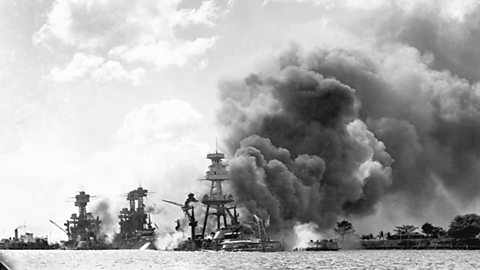The end of isolationism
After World War One, US foreign policy and public opinion moved towards isolationismA policy of embracing national isolation and avoiding involvement in international affairs, often adopted by the USA throughout the 20th century. Isolationists did not want to become involved in international politics or conflicts. America had not joined the League of Nations, an international peace-keeping organisation set up in 1920. However, by the end of 1941 this policy had shifted, and America entered World War Two.

Isolationism and the Neutrality Acts
In 1934, CongressThe legislative body of the US government, made up of the Senate and the House of Representatives. appointed a committee to investigate how the USA had become involved in World War One. The key conclusion of the Nye Committee was that US munitions-makers, industrialists and financers had influenced the governmentтs decision to go to war and had made huge profits from the war.
Although no specific evidence was included, the committee's report gave credibility to the idea that America had only gone to war because of the greed of lobbyistSomeone who tries to persuade politicians to change policies that they care about. To ensure this was prevented in the future, Congress passed a series of Neutrality Acts between 1935 and 1937 that prevented the USA from selling weapons, giving loans or providing financial credit to countries at war, whether they were aggressors or victims.
In 1939, weeks after the start of World War Two in Europe, President Franklin Roosevelt introduced the Cash and Carry policy. According to this policy, countries could only pay cash for any materials bought in the USA, and they also had to have their own ships to carry them away. Although it was neutral at the start of the war, America supported Britain and France against Nazi Germany by selling them American weapons, warships and planes.
Roosevelt was not keen on these limitations. However, the likelihood of global conflict increased and isolation continued to be popular. Therefore, when he was elected president for the third time (in 1940), he stated that Americans would "not be sent into any foreign war".
Lend-lease
As the war continued, Roosevelt became increasingly convinced that isolationism did more harm to American interests than good. By 1940, Britain desperately needed American war supplies but couldnтt afford to buy them.
During one of his fireside chatsThe name given to a series of radio broadcast addresses by President Franklin D Roosevelt to explain his policies in simple terms to the American people. in December 1940, Roosevelt:
- told the American people that the USA should become the "arsenal of democracy"
- explained his plan of lending goods instead of money
Roosevelt found a way to bypass the Neutrality Acts. The Lend-Lease Act of March 1941 authorised the USA to lend or lease war supplies to countries whose defences were judged to be important to the USA. Britain received $7 billion of lend-lease support.
Pearl Harbor

Throughout the 1930s, there had been tensions between Japan and America. These remained high following Japanтs expansion of its influence in the Pacific region. Japan invaded China in 1937 and began a military allianceA union formed for mutual benefit, especially between countries. with Germany and Italy in September 1940.
In response, the USA increased its aid to China. It also applied economic sanctionUsed by governments as a means of punishing another country by limiting or suspending trade and economic relations. and banned exports of oil and steel to Japan. Japan was prepared to make some compromises in return for an end to the ban. Although Roosevelt and his advisers wanted peace, they did not trust Japan to stop its aims of dominating the Pacific region.
The Japaneseтs government therefore decided to go to war with America. On 7 December 1941, Japan carried out a surprise attack on the US naval base at Pearl Harbor, Hawaii. Most of the fleet based there, along with aircraft, was destroyed or damaged. In total, there were approximately 3,500 American casualties, with around 2,400 people killed.